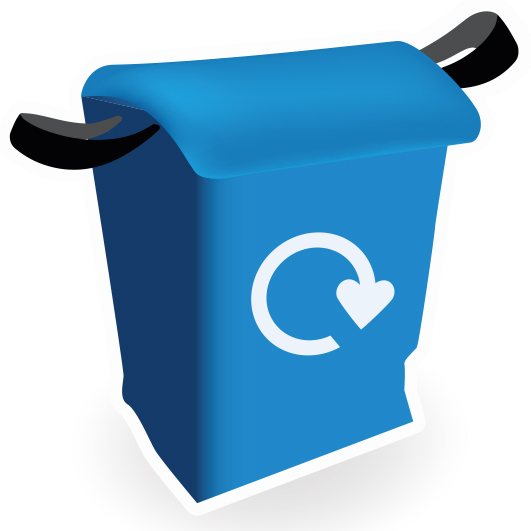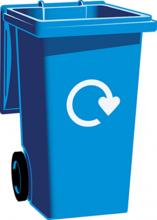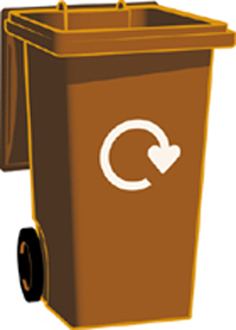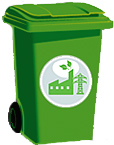Click in the box above and select the item you wish to check. You can also typing the name of the item to jump to.
PLEASE ENSURE THAT LIDS ARE FULLY CLOSED on wheelie and euro bins and they are not over filled.
Unfortunately Biffa will not empty a bin when the lid is raised as this could lead to littering.
You can use the search facility above or watch our Video about what to put in your blue bag.
The Council operates a four stream waste and recycling collection service. Each container is used to collect different waste streams.

The blue bag is used to collect paper and card. It is collected with the blue bin by a collection vehicle with a separate storage for the paper and cardboard. If unaccepted items are put in the blue bag it will not be emptied.

The blue bin is used to collect, glass bottles and jars, tins and cans and plastic bottles, tubs and trays (clean margarine, yogurt and ice cream etc). The materials from this bin are sorted and sent to be reused to make new products. If unaccepted items are put in the recycling bin it will not be emptied.

The brown bin is used to collect organic garden waste. The contents of the brown bin goes to be processed into compost.
 The green bin is used to collect all the other waste that cannot be composted or recycled. The contents of the green bin go to an energy recovery facility where it is used to generate electricity.
The green bin is used to collect all the other waste that cannot be composted or recycled. The contents of the green bin go to an energy recovery facility where it is used to generate electricity.
HWRC
Housing Waste and Recycling Centre
Locations and details can be found on our HWRC webpage
- What should I put in my Blue bag
-
Please use your Blue Bag to recycle the following items/materials
All the below items/materials can be put into your blue bag. We can only accept materials that the recycling facility is capable of sorting so please use this list to guide you.
IMPORTANT: All the recyclables in the blue bag should be put in loose not in bags. Any blue bags found to contain bagged waste will be rejected and not emptied.
What can I recycle?
Paper and cardboard, for example:
- Catalogues
- Cereal boxes
- Corrugated cardboard
- Envelopes
- Greeting cards
- Junk mail
- Magazines
- Newspapers
- Phone directories (including the Yellow Pages)
- Tissue boxes
- Toilet roll tubes
- Writing paper
NOTE: Please do not put milk/fruit juice cartons (Tetra Pak) in the bag with the paper and card. These are made of a composite material of wax, paper and foil and cannot be recycling with paper and card. If any cartons are put into the bag the bag will not be emptied.
Guidelines for the collection of Blue Bag
- Blue bags are put out with your blue bin they need to be put out by 7.00am on collection day. If you have room you can put your bag in the top of your bin.
- Additional recycling placed by the side of the blue bag WILL NOT be collected. If you feel you need additional recycling capacity please contact waste/recycling services on: 01543 462621 or email: wasteservices@cannockchasedc.gov.uk
- Recyclables should not be put into bags as this will not be collected.
- Bins and bags that have unwanted/not-accepted items/materials not listed above will be tagged and left until the contamination i removed. For help and advice if this happens please contact the waste/recycling services on: 01543 462621 email wasteservices@cannockchasedc.gov.uk
-
Missed collections should be reported with 24 hours (by the end of the next working day)
To report a missed bag collection, lost or damaged bag you can report it online 24/7, telephone 01543 462621 or email: wasteservices@cannockchasedc.gov.uk
- What should I put in my Blue recycling bin
-
 Please use your Blue Bin to recycle the following items/materials
Please use your Blue Bin to recycle the following items/materialsAll the below items/materials can be put into your blue recycling bin. We can only accept materials that the recycling facility is capable of sorting so please use this list to guide you.
IMPORTANT: All the recyclables in the blue bins should be put in loose not in bags. Any blue bins found to contain bagged waste will be rejected and not emptied. The rejected bin will be emptied on its next collection date if the recycling is loose and not in bags.
From May 2022 the blue bin will only be used to collect containers such as platstic bottes , glass bottles and jars and tins and cans. Paper and cardboard should be put into the blue bag.
Glass
- Mixed glass bottles and jars - any colour (we can't take window panes, glass cookware/Pyrex, glasses, broken glasses, light bulbs etc)
Metal
- Aerosols
- Foil
- Food tins Steel and aluminium food and drink cans (please wash and squash them)
Plastics and packaging, for example:
- Detergent bottles
- Drinks bottles and tops
- Food trays
- Ice cream tubs
- Margarine tubs
- Plastic milk bottles
- Shampoo bottles
- Yoghurt pots
Please ensure that all recyclables are clean and free from food contamination and are put in the Blue Wheelie Bin LOOSE and NOT IN BAGS.
Please note ** We no longer are able to collect and recycle Tetra Paks (Food & Drink Cartons) in either your Blue Bin or Bag. Therefore, please either place them into your Green Bin or you are welcome to take them to the HWRC's (Tips) in Cannock & Rugeley
For information on how your recycling is sorted visit: What happens to my recycling after collection
Guidelines for the collection of Blue Wheelie Bins (recyclables)
- Blue Bin are to be paced at the rear of the footpath, by 7.00am on collection day.
- Additional recycling placed by the side of the blue bin WILL NOT be collected. If you feel you need additional recycling capacity (larger Blue Bin) please contact waste/recycling services on: 01543 462621 or email: wasteservices@cannockchasedc.gov.uk
- Recyclables should not be put into bags as this will not be collected. Recyclables should be put loose in the blue wheelie.
- Bins that are contaminated with items/materials not listed above will be tagged and left until the contamination is removed. For help and advice if this happens please contact the waste/recycling services on: 01543 462621 email wasteservices@cannockchasedc.gov.uk
-
Missed collections should be reported with 24 hours (by the end of the next working day)
To report a missed bin collection, lost or damaged bin you can report it online 24/7, telephone 01543 462621 or email: wasterservices@cannockchasedc.gov.uk
- What should I put in the Brown bin
-

Organic Garden Waste Service
(Brown Wheelie Bin)
Your brown bin is for the collection of compostable garden waste.
Please put all your garden waste into the brown bin loose, not in bags.
It is very important that only approved materials are put in the garden waste bin as contamination could result in the whole load being spoilt and rejected resulting in the material not being composted.
If your bin contains contaminants the bin will be tagged with a tag and not emptied. We will empty the bin on your next collection day only if the contaminants have been removed. If you continue to put unaccepted items in your brown bin and we continue to reject it we eventually remove the garden waste service from your property.
For further information please see the below lists of acceptable and non-acceptable materials and the frequently asked questions.
What you should put in the brown bin
- Grass cuttings / Clippings
- Leaves
- Hedge and Plant Clippings / Trimmings
- Tree Pruning’s, Bark, Twigs and Small Branches
- Shrub Trimmings
- Garden Vegetable Matter (such as leaves, trimmings, stalks and other vegetable matter directly from gardens (or allotments)).
- Fallen Fruit, Stalks, Husks and Pods
- Weeds and Cut Flowers, (excluding any notifiable or noxious weeds…. such as Japanese Knotweed, Rhododendron, Yew, Ragwort or Hemlock)
- Chipped Bark
- Real Christmas trees (broken up)
What you should NOT put in the brown bin
- Tea Bags & Coffee Grounds
- Food waste from the kitchen
- Japanese Knotweed
- Waste from professional gardeners
- Pond Weeds and residues
- Mulch
- Nappies and sanitary products
- Compostable bags / sacks Any food waste - such as meat and bones, veg or peelings, dairy products, eggs and bread and bakery products.
- plastic liners/plastic bags/biodegradable/compostable bags
- bagged waste
- general or household waste
- furniture/garden furniture
- bricks, rubble and soil
- diseased plants
- building materials
- animal bedding and animal faeces (poo)
- turf
- plastic toys
- timber
- batteries
- plastic buckets
- thermos flasks
- glass
- foil
- chinaware
- textiles
- packaging foam
- carpet
All of the materials in the "what not to put in" list are not suitable for making compost.
Guidelines for the collection of Brown Bin (compostable waste)
- Bins are to be placed out, at the rear of the footway, by 7.00am on the collection day. Wheelie bins will be returned to the rear of the footway.
- Only the contents of the brown bin will be collected by the refuse team. Do not leave any refuse in bags at the side of the bin as they will not be collected and may be classed as flytipping
- Please ensure bin lids are closed or they will not be emptied.
- Do not use compostable/plastic looking bags.
- Overweight bins will not be emptied. The bin lifts have a maximum lifting weight of 96kg.
- Red tags will be left on bins explaining why they have not been taken and residents must take out the contaminants and put out for collection on the next brown bin day
- Missed collections should be reported with 24 hours (by the end of the next working day)
To report a missed bin collection, lost or damaged bin you can report it online 24/7, telephone 01543 462621 or email: wasteservices@cannockchasedc.gov.uk
- What should I put in the Green bin
-
 Green Bins (Household)
Green Bins (Household)Every household in the district is provided with a green bin for the collection of non-hazardous household waste.
Examples of what can go into your green wheelie bin are:
- Polystyrene
- Waxed Food/juice cartons (Tetra Pak)
- Waxed paper (ie off loaves of bread)
- Cold ashes from a coal fire or wood burner
- Pet litter
- Tissues and wipes
- Pet faeces (should be wrapped in newspaper or bag to prevent smells)
- Generally any items not currently allowed in the blue/brown bins
- Sanitary products (incontinence products may need double bagging in hot weather to prevent smells)
- General or household waste
- Crisp packets and other plastic/foil packets
- Nappies and hygiene products
- Shredded paper
- Food
- Plastic toys
- Hard plastics
- Plastic buckets
- Thermos flasks
- Glass cookware (pyrex), glazing (windows) and from picture frames
- Chinaware/pottery
Please do not put the below in the green bin.
They can be taken to the Household Waste Recycling Centre (Tip)
- Paint and Oils
- Hazardous Waste and Chemicals
- Gas Bottles
- Small household (appliance) batteries (they can also be taken to supermarkets as they have a duty to take them back).
- Fluorescent Tubes
Guidelines for collection of green bins
- Bins are to be placed out, at the rear of the footpath, by 7.00am on the collection day. Bins put out late will not be collected until the next collection. Bins will be returned to the rear of the footpath.
- Please ensure bin lids are closed or they will not be emptied.
- Do not leave any refuse in bags at the side of the bin as this will not be collected and may be classed as flytipping
- Overweight bins will not be emptied. The bin lifts have a maximum lifting weight of 96kg.
- Tags will be left on bins explaining why refuse has not been taken
- Households having 6 or more people in residence or those with medical issues may be entitled to a larger bin in replacement of their normal bin. This will only occur if residents are using the wheelie bin recycling service correctly.
- Missed collections should be reported with 24 hours (by the end of the next working day)
To report a missed bin collection, lost or damaged bin you can report it online 24/7, telephone 01543 462621 or email: wasteservices@cannockchasedc.gov.uk
- Frequently Asked Questions – Waste & Recycling
-
Below are some common asked questions in regards to the waste and recycling collection service.
Why are we stopping residents from disposing of food waste with their garden waste?
There are a number of reasons, in brief they are:
- Expensive considering the amounts of food waste being disposed of.
- Not widely used by all residents
- Only one local disposal point
- General waste is now used to create energy (see below)
- Not uncommon across Staffordshire
- Increasing financial pressure on Councils
- Saving will help to protect and develop other services
Do other local Councils collect food waste only in the normal household waste bin?
Yes, Lichfield, Tamworth, South Staffordshire and Stafford Borough Councils all collect their residents food waste with their general waste and do not compost it.
Why is the Council still sending general and now food waste to landfill?
We are not; since Oct 2013 general waste from across Staffordshire, including our Councils, has been disposed of by incineration at a plant in Staffordshire and used to create energy
Why doesn’t the Council do more to help the environment?
We try to reuse, recycle or recover as much as we can from the waste our residents create.
How does Cannock Chase Council compare to other Councils across the country?
Cannock Chase Council along with most other Councils across Staffordshire is in the top 25% of Councils across England for its recycling performance.
Why does the Council keep changing the waste service?
It doesn’t, the last large scale improvement of the waste service came in 2010 with the introduction of wheeled bins for dry recycling.
How much garden and food waste does the Council dispose of each year?
On average the Council disposes of around 9,000 Tonnes per year.
How much food waste does the Council dispose of each year as part of its garden and food waste collection service?
The Council estimates that only between 10-12% of its total garden and food collection is made up of food waste.
How much more expensive is it to dispose of mixed garden and food waste than just garden waste?
It costs over double the amount to dispose of mixed garden and food waste than garden waste alone per tonne.
Why is it so much more expensive?
Because of animal by-products mixed garden and food waste has to be disposed of in a much more controlled environment at controlled temperatures and cannot be initially allowed to rot away naturally as garden waste alone can.
What options are there for disposing of food waste?
Food waste could be disposed of by using the general (green) bin or garden and food (brown) bin in the past. But now due to the cost and the low amounts of food waste being disposed of the Council cannot justify the expense of disposing of mixed garden and food waste.
What if I get maggots and flies?
Maggots and flies can be kept to a minimum by wrapping food waste in waste /news paper or small waste bags such as pedal bin liners.
Can I compost my food waste at home?
Yes you can, the Council’s website has some hints and tips on home composting and the Council may even provide you with a free composter.
Why is it so important to get the right things in the right bin?
Bins that are contaminated cannot be recycled. If they are added to a recycling load the whole load of between 8-10 Tonnes of good recycling may be rejected at the disposal point. It may also have to be sent to landfill as at that point it is no longer classed as domestic but commercial waste.
What if residents get it wrong?
If a resident gets it wrong their bin will be tagged and will be left un-emptied. They will be required to remove the contamination before the bin will be emptied on the next collection day.
What if residents continually get it wrong?
While the provision of a general waste collection is a statutory requirement, the provision of dry recycling and garden waste collections are not and therefore can be removed by the Council if it considers a resident is not using them correctly.
Does the Council have any legal powers in relations to waste and recycling?
Yes, Under Section 46 of the Environmental Protection Act 1990 the Council has the power to decide the type of service provision it provides and specify how it should be used by residents.
How do I know what goes into what bin?
The Council uses a number of methods to help its residents identify what items go into what bin including:
- Council Website
- ‘Which Bin’ website widget
- Annual waste and recycling calendars
- Leaflets
What are the top 5 contaminators of dry recycling?
In no particular order they are:
- Nappies
- Animal Bedding
- Textiles
- DIY Materials (including paint tins and paint)
- Waste electrical goods in the bin.
Can I recycle my old clothes, textiles and shoes, in my blue bin with my other dry recycling?
Unfortunately, the Councils materials recycling facility can not take clothing, textiles or shoes. They require a different process to be sorted and can become contaminated by other recycling if mixed; making them un-reusable. Clothing, textiles and shoes can however all be recycled (along with other products such as small waste electrical and electronic goods) at your Local Recycling Centres at many supermarkets and carparks across the district or at the Household Waste and Recycling Centres (HWRC’s) in Cannock or Rugeley.
